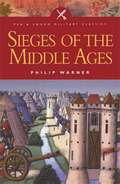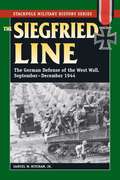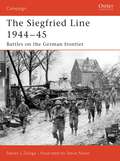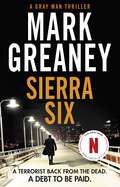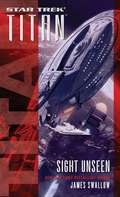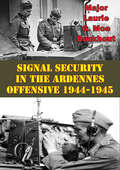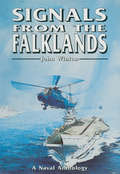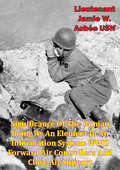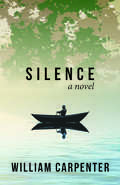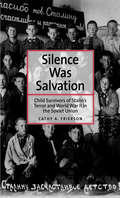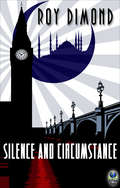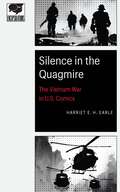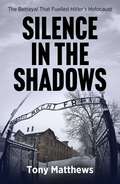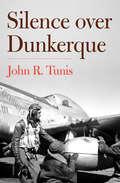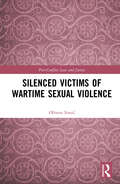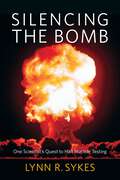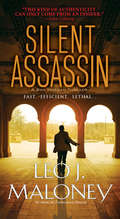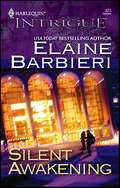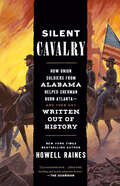- Table View
- List View
Siege of Malta, 1940–42: Rare Photographs from Veterans' Collections (Images of War)
by Anthony RogersThe story of a Mediterranean island under constant bombardment: “Packed with over 200 photographs, this book is a must for any World War II enthusiast.” —The Sunday Times of MaltaFor nearly two and a half years, from June 1940 until late 1942, Malta was subjected to one Axis air raid after another. The Mediterranean island was effectively beleaguered, reliant for defense on anti-aircraft guns and often-outnumbered fighter aircraft and dependent for survival on naval supply convoys.The Axis attempted to bomb and starve Malta into submission, attacking ports and military and industrial areas, leading to Malta becoming one of the most heavily bombed areas of the Second World War, with well over three thousand alerts before the end of hostilities. But against the odds, and at heavy cost, Malta was held. Malta was vital to Allied success in North Africa, dominating Axis supply routes to the region. It was a remarkable, intense campaign, a crucial turning point in the Second World War, and one of the Allies’ greatest tactical and strategic victories.This is an account of that desperate time, as witnessed by those who were there and illustrated with their wartime photographs, together with color images of Malta today.
Siege of Malta, 1940–42: Rare Photographs from Veterans' Collections (Images of War)
by Anthony RogersThe story of a Mediterranean island under constant bombardment: “Packed with over 200 photographs, this book is a must for any World War II enthusiast.” —The Sunday Times of MaltaFor nearly two and a half years, from June 1940 until late 1942, Malta was subjected to one Axis air raid after another. The Mediterranean island was effectively beleaguered, reliant for defense on anti-aircraft guns and often-outnumbered fighter aircraft and dependent for survival on naval supply convoys.The Axis attempted to bomb and starve Malta into submission, attacking ports and military and industrial areas, leading to Malta becoming one of the most heavily bombed areas of the Second World War, with well over three thousand alerts before the end of hostilities. But against the odds, and at heavy cost, Malta was held. Malta was vital to Allied success in North Africa, dominating Axis supply routes to the region. It was a remarkable, intense campaign, a crucial turning point in the Second World War, and one of the Allies’ greatest tactical and strategic victories.This is an account of that desperate time, as witnessed by those who were there and illustrated with their wartime photographs, together with color images of Malta today.
Sieges of the Middle Ages (Pen & Sword Military Classics)
by Philip WarnerIn the Middle Ages the castle was an important military and administrative centre, essentially utilitarian in its design and in the purposes it served. Because it played so central a role in medieval history, and because the wealth of material is so great, the author has concentrated on English seiges undertaken in the period from the Norman Conquest to the War of the Roses. This includes many dramatic actions fought on the continental dominions of the English Crown such as Chateau Gaillard and Rouen. Drawing from contemporary records and his own inpsection of sites, Philip Warner's narrative explores the skills of the architect, the engineer and the miner, as well as the courage of troops and their commanders.
Siegfried Line (Stackpole Military History Series)
by Samuel W. Mitcham Jr.The battles for the Germans' last line of defense in World War II, including Arnhem, Aachen, the Huertgen Forest, and MetzHow German commanders made decisions under fireBuilt as a series of forts, bunkers, and tank traps, the West Wall--known as the Siegfried Line to the Allies--stretched along Germany's western border. After D-Day in June 1944, as the Allies raced across France and threatened to pierce into the Reich, the Germans fell back on the West Wall. In desperate fighting--among the war's worst--the Germans held off the Allies for several months.
Siegfried Line (Stackpole Military History Series)
by Samuel W. Mitcham Jr.The battles for the Germans' last line of defense in World War II, including Arnhem, Aachen, the Huertgen Forest, and Metz. How German commanders made decisions under fire.
Siegfried Line 1944-45: Battles on the German Frontier
by Steven Zaloga Steve NoonThe Siegfried Line campaign was one of the most frustrating and bloody series of battles fought by the US Army in Northwest Europe during World War II (1939-1945).In order to break through the German-Belgian border north of the Ardennes and eventually reach the Rhine, the First and Ninth divisions of the US Army dispersed themselves along the German Siegfried Line.The campaign kicked off in earnest in late September with the encirclement and eventual capture of Aachen, the first major German city to fall to the Allies. The paths to the Roer included not only the heavily urbanized area northeast of this city, but also the Hurtgen Forest along its southeastern flank. While a costly battle to seize the city continued throughout October, fighting also began in the forested area with initial attacks towards Schmidt.The German offensive to the south in the Ardennes derailed the Siegfried campaign for nearly two months and proved to be extremely costly. However, with Operation Grenade in February 1945, Ninth Army were finally propelled over the Roer River and were able to seize the vital Roer dams.Providing extensive coverage of the battle for Aachen and the fighting that ensued in the Hurtgen Forest, this title brings to life the Siegfried Line campaign which witnessed the US Army's most bitter fighting and set the stage for the final assault on the Rhine, leading the way into the heart of Germany.
Sierra Six: The action-packed new Gray Man novel - soon to be a major Netflix film (Gray Man #11)
by Mark GreaneyTHE LATEST ALL-ACTION THRILLER IN THE GRAY MAN SERIES - SOON TO BE A MAJOR NETFLIX FILM.Before he was the Gray Man, Court Gentry was Sierra Six, the junior member of a CIA action team.In their first mission they took out a terrorist leader, but at a terrible price - the life of a woman Court cared for. Years have passed and now The Gray Man is on a simple mission when he sees a ghost: the long-dead terrorist, but he's remarkably energetic for a dead man.A decade may have gone by but the Gray Man hasn't changed. He isn't one to leave a job unfinished or a blood debt unpaid.-------'I love the Gray Man'Lee Child'So propulsive, the murders so explosive, that flipping the pages feels like playing the ultimate videogame'New York Times'Bourne for the new millennium'James Rollins'Intense, explosive, daring, funny, and ultimately just flat out awesome'Ben Coes
Sierra-Nevada Lakes: The American Lakes Series
by George Henry Hinkle Bliss McGlashan HinkleOf the world’s famous mountain ranges, the Sierra Nevada is one of the most spectacular in the number and variety of its lakes. From Lassen Peak in the north to Mount Whitney in the south, the crest and Banks of the great barrier are flecked with the blue of thousands of them—there are 429 in Yosemite Park alone, and in a single area of 220 square miles at the southern end of Lake Tahoe there is a galaxy of more than a hundred. These ice-blue pools lie casually in the most unexpected places—in bleak cirques well above timber line, in river bottoms, in densely timbered canyons, and on the summits of boulder-strewed passes. They range in size from navigable bodies of 300 square miles to small glacial ponds of a few acres. Almost every imaginable geologic origin is represented somewhere among them, as well as some unimaginable freaks of contour. As John Muir was probably the first to point out, theirs is the charm of the unpredictable.Around them centers much of the history of California and Nevada, and until now no comprehensive effort has been made by anyone to narrate it. Dr. and Mrs. Hinkle, who are well-nigh ideally equipped to delineate the fascinating history of the Sierra lakes and their near-lying Great Basin neighbors. Both are the descendants of long lines of pioneer forebears. Both were born and grew up in Truckee, the main gateway of the transcontinental route between Nevada and California. Both are inheritors of a great love for the region and of a great mass of family and traditionary lore concerning it. Both are trained in the employment of bibliographical and historical tools for the writing of history. Finally, as husband and wife, they constitute a well-geared, smoothly functioning literary team, each member of which reinforces and supplements the labors and perceptions of the other.
Sight Unseen (Star Trek: The Next Generation)
by James SwallowAn original spin-off novel set in the popular Star Trek: The Next Generation universe from New York Times bestselling author James Swallow!In the wake of political upheaval across the United Federation of Planets, Admiral William Riker and the crew of the U.S.S. Titan find themselves in uncertain waters as roles aboard the ship change to reflect a new mandate and a new mission. On orders from Starfleet, Titan sets out toward the edge of Federation space to tackle its latest assignment: to work with an alien species known as the Dinac, who are taking their first steps into the galaxy at large as a newly warp-capable civilization. But when disaster befalls the Dinac, the Titan crew discovers they have unknowingly drawn the attention of a deadly, merciless enemy—a nightmare from Riker’s past lurking in the darkness. Friendships will be tested to the limit as familiar faces and new allies must risk everything in a fight against an unstoppable invader—or a horrific threat will be unleashed on the galaxy! ™, ®, & © 2015 CBS Studios, Inc. STAR TREK and related marks and logos are trademarks of CBS Studios, Inc. All Rights Reserved.
Sigmund Freud and the Jewish Mystical Tradition
by David BakanDiscover the intriguing connections between one of the most influential figures in psychology and the rich heritage of Jewish mysticism in David Bakan's seminal work, "Sigmund Freud and the Jewish Mystical Tradition." This groundbreaking book offers a unique perspective on Sigmund Freud, the father of psychoanalysis, exploring how his Jewish background and mystical traditions may have shaped his theories and ideas.David Bakan, a distinguished psychologist and historian, meticulously examines Freud's life and work, delving into the cultural and religious milieu that influenced his development. Bakan presents a compelling argument that many of Freud's concepts, such as the unconscious, repression, and the interpretation of dreams, have parallels in Jewish mystical thought, particularly in the Kabbalah."Sigmund Freud and the Jewish Mystical Tradition" provides a thorough analysis of Freud's writings and personal correspondence, highlighting elements that suggest a deeper connection to his Jewish heritage than previously acknowledged. Bakan explores how Freud's upbringing in a Jewish family, his exposure to Jewish texts, and the mystical traditions that permeated his cultural environment may have subtly influenced his pioneering work in psychoanalysis.Through detailed research and insightful interpretation, Bakan bridges the worlds of psychology and mysticism, offering readers a fresh understanding of Freud's intellectual legacy. The book delves into the historical context of Freud's time, the Jewish mystical tradition's key concepts, and how these might have intersected with Freud's groundbreaking ideas.This book is essential reading for scholars of psychology, students of Jewish studies, and anyone interested in the cross-cultural influences that shape intellectual history. "Sigmund Freud and the Jewish Mystical Tradition" not only enriches our understanding of Freud's work but also invites readers to appreciate the profound and often unexpected ways in which cultural and spiritual traditions intersect with scientific inquiry.
Signal Security In The Ardennes Offensive 1944-1945
by Major Laurie G. Moe BuckhoutThis thesis investigates the significance, theory and practice of tactical signal security (SIGSEC) during the Ardennes Offensive of 1944-1945. The work includes a brief introduction to the offensive and to the history of SIGSEC, and examines how the American and German armies safeguarded communications from the enemy. Inherent in this study was an investigation of actions taken by these armies to exploit their adversary's SIGSEC and the processing and exploitation of the signal intelligence (SIGINT) they obtained.The study concludes that both armies had similar equipment, basic procedures, and training in the areas of communications, SIGSEC and SIGINT, and suffered similar deficiencies in these areas. Analysis, however, revealed a deep disparity concerning their use and importance. The Americans' near complete lack of regard for tactical SIGINT was a major factor contributing to the success of Hitler's deception. The U.S. Army relied heavily upon intelligence gleaned from the German ULTRA code, and American intelligence officers were untrained in the use of tactical signal intelligence, mainly using it to validate operational plans. This attitude is reflected also in the American emphasis on SIGSEC. The Germans, however, were more experienced in SIGINT and SIGSEC, and formed a structure and doctrine that focused on immediately influencing tactical operations.
Signals From the Falklands: A Naval Anthology
by John WintonA naval historian presents a collection of personal accounts from British naval servicemembers who contributed to victory in the Falklands. Fearing that the achievements of Britain&’s Navy in the Falklands War would go unrecognized, John Winton let it be known that he was compiling a book of personal, firsthand accounts on the subject. The response was overwhelming, and Signals from the Falklands represents only a fraction of the stories, letters, journal entries, and recorded interviews he received. Here is a candid recounting of that brief but successful campaign from those who served in all ranks and trades with the Royal Navy and the Royal Fleet Auxiliary. Some of the contributors, like the aptly named Sam Salt will be familiar to many; others are not well known. All who served on board any ship which &‘went south&’ in that strange nut epic endeavor in 1982 will be grateful to John Winton for this lasting tribute to their bravery, their sacrifice, and their abiding sense of humor.
Signature Wound: Hidden Bombs, Heroic Soldiers, and the Shocking, Secret Story of the Afghanistan War
by Bob DruryNominated for The National Magazine Awards, Public Interest categoryEvery war has its "signature wounds," injuries inflicted by frightening new weapons and tactics the U.S. military has never faced before. Blistered flesh from mustard gas in World War I. Petroleum burns from oil and gas igniting on the surface of the Pacific in World War II. And now, lost legs, hands, and most devastating of all, genitals, as a result of improvised explosive devices (IEDs) in today's war in Afghanistan. Men's Health contributing editor Bob Drury, a veteran reporter of both the Afghan and Iraq wars, delivers his most hard-hitting and important dispatch yet--the unforgettable accounts of U.S. soldiers who have suffered these very personal wounds. Their intense tales of battlefield survival are just a prologue to the unimaginable fights they face once they're stateside. This is essential reading for truly understanding what our fighting forces put on the line--and lose--every single day.
Significance Of The Human Being As An Element In An Information System: WWII Forward Air Controllers And Close Air Support
by Lieutenant Jamie W. Achée USNThis research will explore the relevance of the human being as an element in an information system. The purpose of this study is to analyze the influence technology, especially information technology, has had on the way human beings understand and use information systems. This study will look at the use of forward air controllers and close air support in the European Theater of Operations during WWII and evaluate the technology, the doctrine and the people involved as they related to the forward air control-close air support information system. Other areas that will be discussed as they relate to the development of close air support include: incremental vs. radical change, organizational culture and change, and the dynamic nature of current and future operations as they relate to information systems.The primary research objective is to explore the answer to the following question: Based on the role of forward air controller in the European Theater of Operations during World War Two, what is the significance of the human being as an element in an information system? Secondary questions include: What are the necessary elements that make up an information system? How and where were forward air controllers used and were they effective? What were the information systems used by the forward air controllers and were they effective? Last, what implications do the findings of this research have for current technologies, organizational structure and the interaction between human beings and information systems in U.S. military operations?
Silence
by William CarpenterNick Colonna is a young veteran returning from Iraq to the coast of Maine after an IED explosion kills his entire crew and leaves him deaf. Struggling with trauma, Nick finds solace in memories of nearby Amber Island—a private sanctuary owned by a Boston family set on development, much to the despair of its youngest daughter, Julia. As Nick battles his inner demons, Julia fights her family, and Amber Island faces demolition, Carpenter raises questions about what survives carnage and loss and where—in a divided and chaotic world—is there room for peace and silence.
Silence Was Salvation
by Cathy A. FriersonRoughly ten million children were victims of political repression in the Soviet Union during the Stalinist era, the sons and daughters of peasants, workers, scientists, physicians, and political leaders considered by the regime to be dangerous to the political order. Ten grown victims, who as children suffered banishment, starvation, disease, anti-Semitism, and trauma resulting from their parents’ condemnation and arrest, now freely share their stories The result is a powerful and moving oral history that will profoundly deepen the reader’s understanding of life in the U. S. S. R. under the despotic reign of Joseph Stalin.
Silence and Circumstance
by Roy DimondHistorical fact and tantalizing fiction merge in this unique interwar thriller about Agatha Christie&’s mysterious disappearance in 1926. When Agatha Christie disappeared for eleven days in December, 1926, all of England was abuzz with speculation. Did the great writer really just &“black out,&” only to somehow reappear days later at a spa hotel? Could she be a pawn trapped in an international mystery? Or was she the puppet-master? The adventure unfolds through the perspective of Christie&’s trusted governess, Charlotte &“Carlo&” Fisher. After receiving a mysterious letter, Charlotte embarks on a harrowing quest, aided by many of the famous and elite of the twentieth century. While Sir Arthur Conan Doyle and his protégé, Ian Fleming, speed towards Istanbul on the Orient Express in search of Agatha&’s diary, Charlotte discovers clues that dispatch her to Berlin where she stumbles into a world gone mad. With a dizzying cast of characters that includes Dorothy Parker, Pablo Picasso, Lillian Hellman, J.R.R. Tolkien, and many others, this historical adventure delves into the shadows of mysterious societies, where it appears something dark is rising . . .
Silence in the Quagmire: The Vietnam War in U.S. Comics (Encapsulations: Critical Comics Studies)
by Harriet E. EarleIn Silence in the Quagmire Harriet E. H. Earle uses silence to construct a narrative of the Vietnam War via U.S. comics. Unlike the vast majority of cultural artifacts and scholarly works about the war, which typically focus on white, working-class American servicemen and their experiences of combat, Earle&’s work centers less-visible players: the Vietnamese on both sides of the conflict, women and girls, and returning veterans. Earle interrogates the ways this conflict is represented in American comic books, with special focus on these missing groups. She discusses how—and more critically why—these groups are represented as they are, if they&’re represented at all, and the ways these representations have affected views of the war, during and since. Using Michel Foucault&’s understanding of silence as discourse, Earle considers how both silence and silencing are mobilized in the creation of the U.S.-centric war narrative. Innovative in its structure and theoretical scaffolding, Silence in the Quagmire deepens our understanding of how comic books have represented the violence and trauma of conflict.
Silence in the Shadows: The Betrayal That Fuelled Hitler's Holocaust
by Tony MatthewsThe Moment the World Doomed Six Million to Die. In July 1938 the United States, Great Britain and thirty other countries participated in a vital conference at Évian-les-Bains, France, to discuss the persecution and possible emigration of the European Jews, specifically those caught under the anvil of Nazi atrocities. However, most of those nations rejected the pleas then being made by the Jewish communities, thus condemning them to the Holocaust. There is no doubt that the Évian conference was a critical turning point in world history. The disastrous outcome of the conference set the stage for the murder of six million people. Today we live in a world defined by turmoil with a disturbing rise of authoritarian governments and ultra right-wing nationalism. The plight of refugees is once more powerfully affecting public attitudes towards those most in need. Now, on the 80th anniversary of the liberation of Auschwitz and the end of the Second World War, it&’s time to reflect on the past to ensure we never again make the same mistakes. This book also shines a spotlight on some of the astonishing and courageous stories of heroic efforts of individuals and private organizations who, despite the decisions made at Évian, worked under extremely dangerous conditions, frequently giving their own lives to assist in the rescue of the Jewish people. "This account of the failure of the Évian Conference of 1938 to secure a managed and safe emigration of the primarily Jewish populations of Germany and Austria, is a frightening indictment of the &‘refuge nations&’ attitude to those peoples." – Sandra Miller, NetGallery &“Shines a spotlight on some of the astonishing and courageous stories of heroic efforts of individuals and private organisations who, despite the decisions made at Évian, worked under extremely dangerous conditions, frequently giving their own lives to assist in the rescue of the Jewish people." – Araciapod.com
Silence over Dunkerque
by John R. TunisA historical novel about one man&’s experience of the evacuation of Dunkirk: &“A lively tale around one of the turning points of World War II&” (The New York Times). Sergeant Edward Williams of the Second Battalion was among the first British troops to land in France, just across the English Channel from his family in Dover, after the declaration of war in September of 1939. Battles have been few and far between since then, in what the Germans have been calling der Sitzkrieg—the sitting war. In May 1940, under the leadership of their new prime minister, Winston Churchill, the British are hoping to stem the tide of Nazi invasion along their southern border. But now, flanked to the east and west by German troops and cut off from the Allies further south, Sergeant Williams and his battalion must retreat to Dunkerque in the north, and escape by sea is their only hope.
Silenced Victims of Wartime Sexual Violence (Post-Conflict Law and Justice)
by Olivera SimicThe condemnation of wartime sexual violence as a gross violation of human rights has received widespread support. While rape and other forms of sexual violence have attracted considerable local and international attention, this often excludes wartime sexual violence among women belonging to so-called ‘perpetrator’ war-torn nations. This book explores the silence surrounding women’s experiences of wartime sexual violence within academic, legal and public discourses. Olivera Simić argues that the international criminal law and feminist legal discourse on wartime sexual violence can construct a problematic victim hierarchy that excludes and misrecognises certain women’s experiences of sexual violence during and after armed conflict. The book focuses on the experiences of Bosnian Serb women, where the collapse of the former Yugoslavia led to brutal war and gross human rights violations throughout the 1990s. Two decades after the war, women in Bosnia and Herzegovina are still facing the legacies of the violence in the 1990s. Through this case Simić argues that while all women survivors of rape face problems of stigma, shame and lack of political visibility, their legal and symbolic status differ according to their ethno-national identity. Drawing on interviews with Bosnian Serb women survivors of rape in Bosnia and Herzegovina, feminist activists, local media, documentary and archival sources, the book examines ‘post-conflict justice’ as it is seen, lived and interpreted by women who belong to ‘perpetrator’ nations and will be of great interest and use to researchers, students and practitioners within post-conflict law and justice, international criminal law, security studies and gender studies.
Silencing the Bomb: One Scientist's Quest to Halt Nuclear Testing
by Lynn R. SykesIn December 2016, the Bulletin of Atomic Scientists moved their iconic “Doomsday Clock” thirty seconds forward to two and a half minutes to midnight, the latest it has been set since 1952, the year of the first United States hydrogen bomb test. But a group of scientists—geologists, engineers, and physicists—has been fighting to turn back the clock. Since the dawn of the Cold War, they have advocated a halt to nuclear testing, their work culminating in the Comprehensive Test Ban Treaty, which still awaits ratification from China, Iran, North Korea—and the United States. The backbone of the treaty is every nation’s ability to independently monitor the nuclear activity of the others. The noted seismologist Lynn R. Sykes, one of the central figures in the development of the science and technology used in monitoring, has dedicated his career to halting nuclear testing. In Silencing the Bomb, he tells the inside story behind scientists’ quest for disarmament.Called upon time and again to testify before Congress and to inform the public, Sykes and his colleagues were, for much of the Cold War, among the only people on earth able to say with certainty when and where a bomb was tested and how large it was. Methods of measuring earthquakes, researchers realized, could also detect underground nuclear explosions. When politicians on both sides of the Iron Curtain attempted to sidestep disarmament or test ban treaties, Sykes was able to deploy the nascent science of plate tectonics to reveal the truth. Seismologists’ discoveries helped bring about treaties limiting nuclear testing, but it was their activism that played a key role in the effort for peace. Full of intrigue, international politics, and hard science used for the global good, Silencing the Bomb is a timely and necessary chronicle of one scientist’s efforts to keep the clock from striking midnight.
Silent Assassin (A Dan Morgan Thriller #2)
by Leo J. MaloneyFrom a Black Ops veteran and author of Termination Orders, a military thriller featuring an unthinkable conspiracy from the deepest corridors of power.Silent Assassin Code named Cobra, former CIA agent Dan Morgan is pulled in when every other option has failed. His mission: find Nikolai Novokoff, a ruthless KGB officer turned international arms dealer. Locate the weapons of mass destruction that the rogue terrorist is threatening to unleash on the world. And terminate with extreme prejudice… In the world of clandestine ops, where the line between friends and enemies is constantly shifting, especially in the halls of Washington, Morgan must survive a merciless maze of deceit—and risk everything—to stop a madman.&“Silent Assassin has everything a thriller reader wants.&”—Ben Coes, national bestselling author of The Last Refuge &“A terrifyingly thrilling story.&”—Michele McPhee, author of A Mob Story
Silent Awakening
by Elaine BarbieriHIS SHIELD AND GUN WERE HERS TO COMMANDStalked by a killer after discovering his nearly untraceable chemical weapon, scientist Natalie Patterson collided with one of New York’s finest-rugged homicide detective Brady Tomasini. The elegant scientist and the steel-hard cop should never have met. But now their fiery attraction was as undeniable as it was inconvenient.For the first time, Brady wasn’t in control. Surrendering himself to Natalie’s soft, smoky eyes wouldn’t help him catch the killer. Unless.... The closer they got, the more angry Natalie’s stalker became-and the more careless. Was giving in to unexpected passion the best way to flush out the killer...and would Brady’s and Natalie’s hearts survive the aftermath?
Silent Cavalry: How Union Soldiers from Alabama Helped Sherman Burn Atlanta--and Then Got Written Out of History
by Howell RainesA Pulitzer Prize–winning journalist reveals the little-known story of the Union soldiers from Alabama who played a decisive role in the Civil War, and how they were scrubbed from the history books.&“It is my sincere hope that this compelling and submerged history is integrated into our understanding of our nation, and allows us to embrace new heroes of the past.&”—Imani Perry, professor, Harvard University, and National Book Award–winning author of South to AmericaWe all know how the Civil War was won: Courageous Yankees triumphed over the South. But is there more to the story?As Pulitzer Prize–winning journalist Howell Raines shows, it was not only soldiers from northern states who helped General William Tecumseh Sherman burn Atlanta to the ground but also an unsung regiment of 2,066 Alabamian yeoman farmers—including at least one member of Raines&’s own family.Called the First Alabama Cavalry, U.S.A., this regiment of mountain Unionists, which included sixteen formerly enslaved Black men, was the point of the spear that Sherman drove through the heart of the Confederacy. The famed general hailed their skills and courage. So why don&’t we know anything about them?Silent Cavalry is part epic American history, part family saga, and part scholarly detective story. Drawing on the lore of his native Alabama and investigative skills honed by six decades in journalism, Raines brings to light a conspiracy that sought to undermine the accomplishments of these renegade southerners—a key component of the Lost Cause effort to restore glory to white southerners after the war, even at the cost of the truth.In this important new contribution to our understanding of the Civil War and its legacy, Raines tells the thrilling tale of the formation of the First Alabama while exposing the tangled web of how its wartime accomplishments were silenced, implicating everyone from a former Confederate general to a gaggle of Lost Cause historians in the Ivy League and a sanctimonious former keeper of the Alabama state archives. By reversing the erasure of the First Alabama, Silent Cavalry is a testament to the immense power of historians to destroy as well as to redeem.

